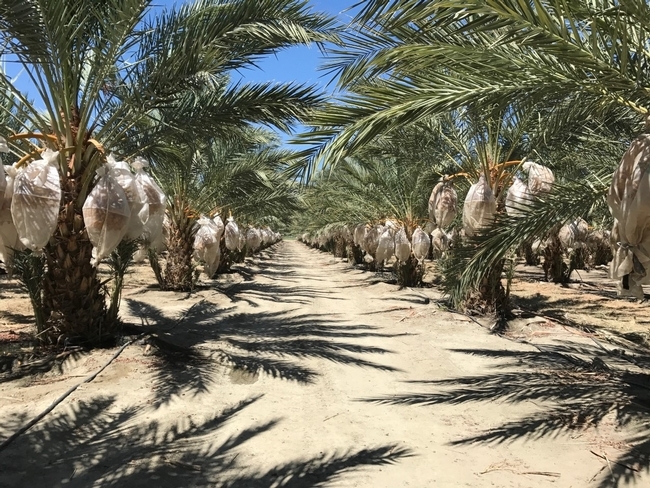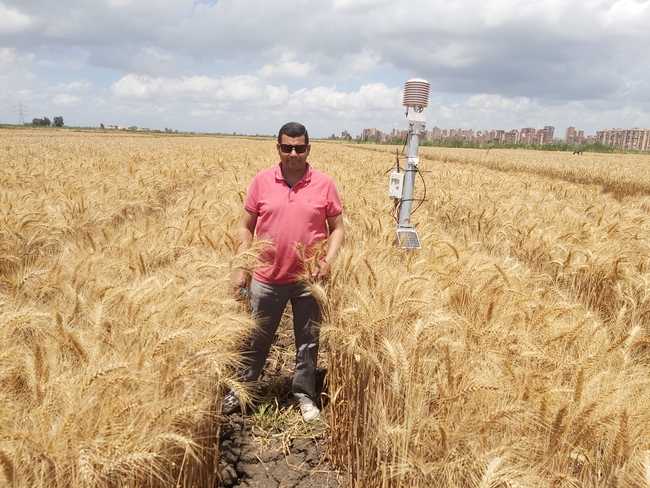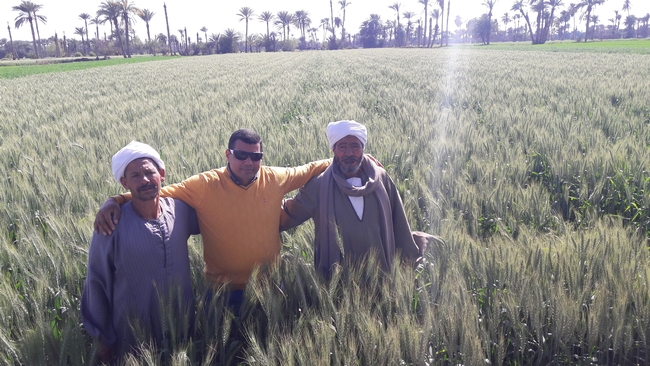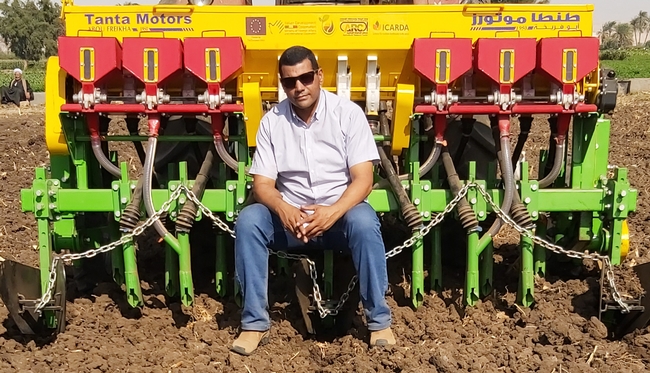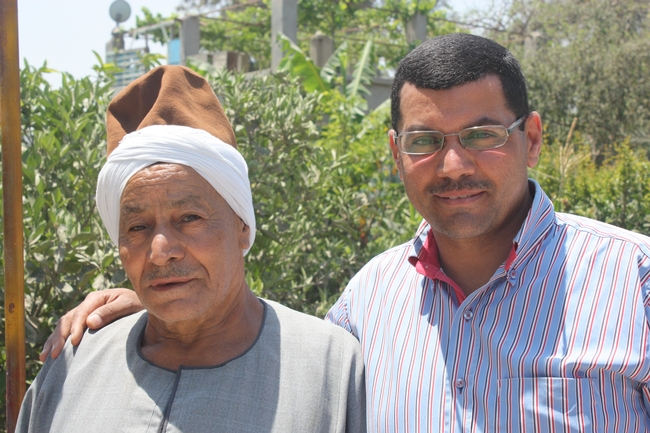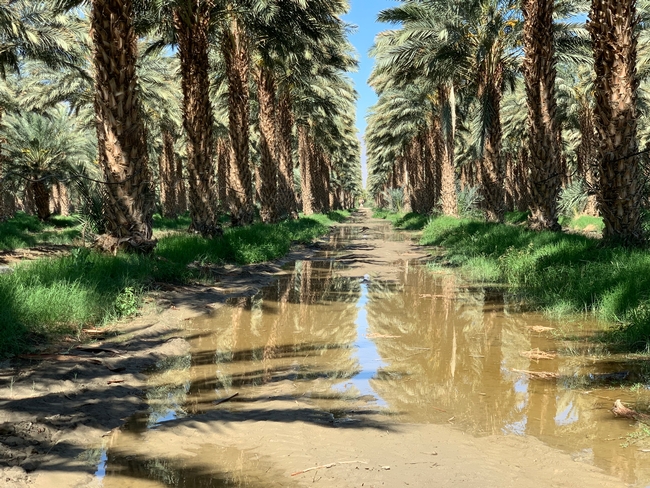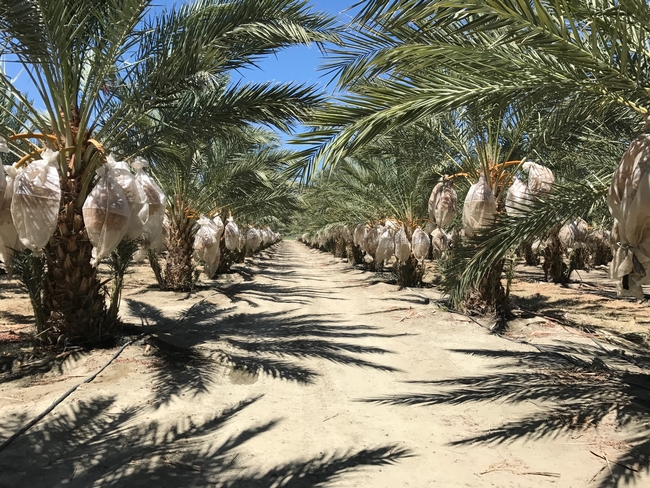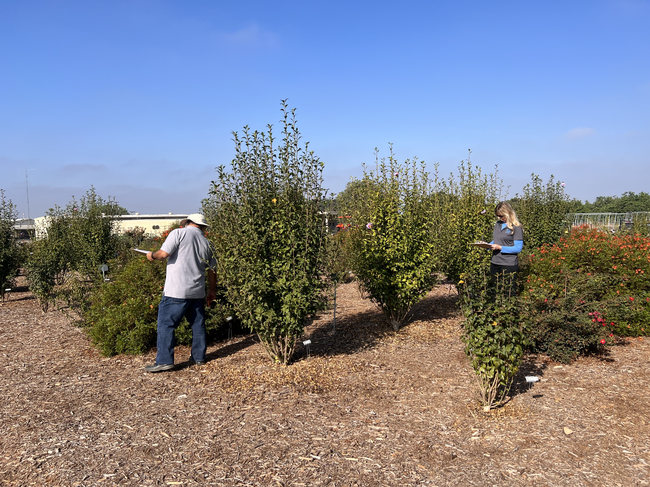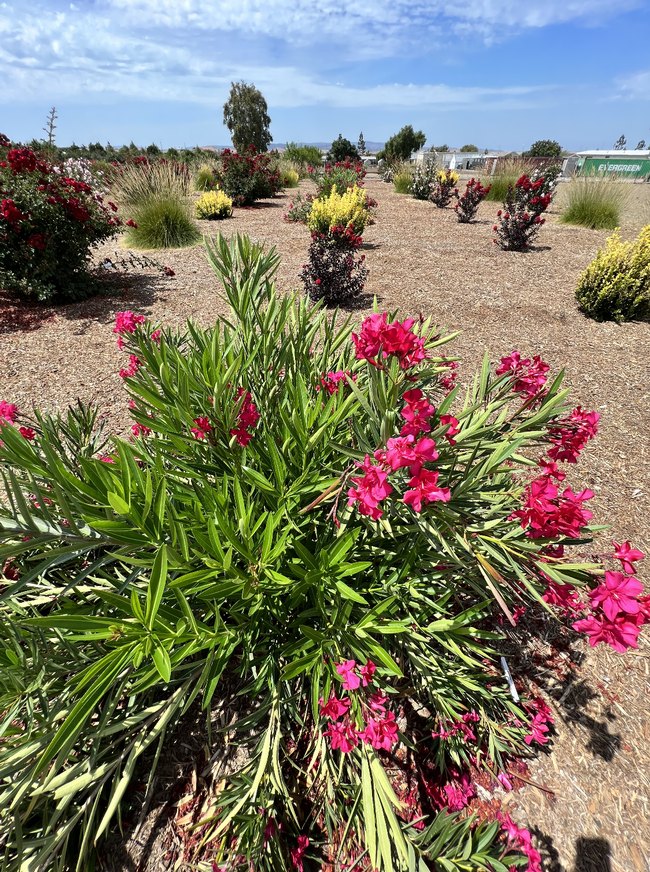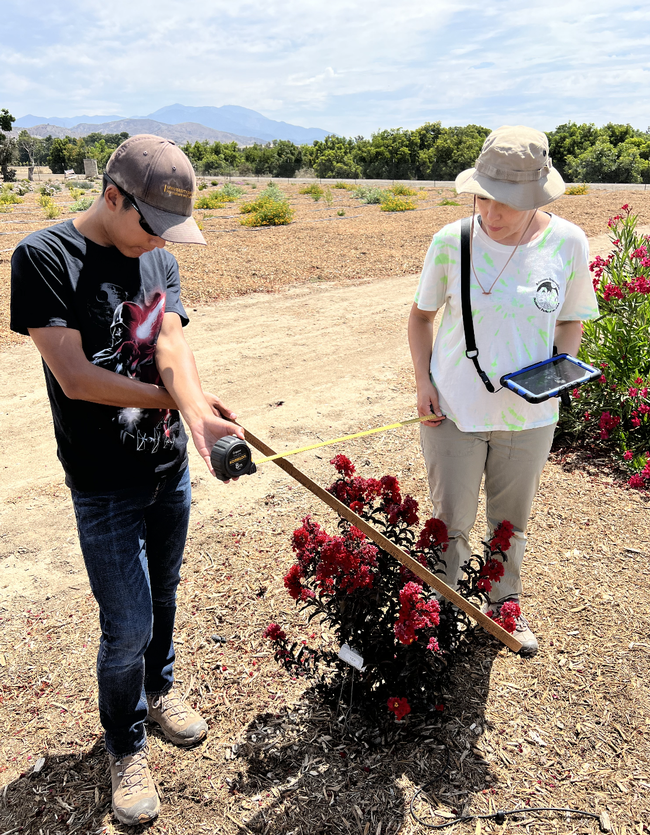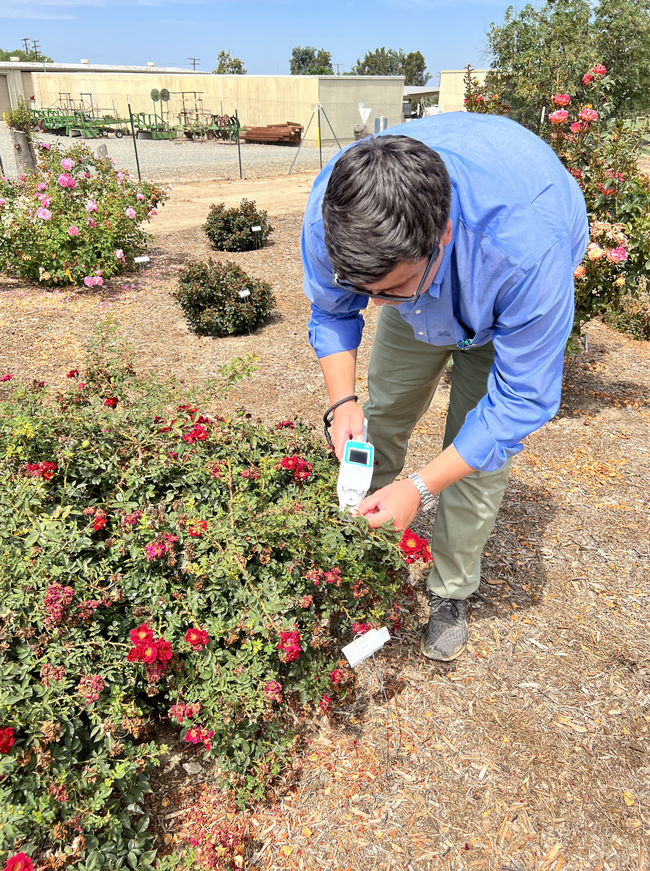Posts Tagged: irrigation
AI and sustainable farming focus of May 7 workshop with UC, partners
On May 7, scientists from University of California, Riverside, UC Agriculture and Natural Resources, Colorado State University Extension, Kansas State University, University of Arizona, Central Arizona Project, and USDA-Agricultural Research Service will gather with growers in Palm Desert to discuss how artificial intelligence can be used in agriculture.
“Artificial intelligence can be used by farmers to save water, improve fertilizer efficiency and increase productivity,” said Khaled Bali, UC Cooperative Extension irrigation water management specialist and organizer of the workshop. “At this workshop, growers will hear about the latest research on AI technology for agriculture and about the experiences of growers who are already testing it in their fields.”
Speakers and topics will include:
- Raj Khosla, Kansas State University - AI for precision nitrogen and water management in row crops
- Michael Cahn, UC Cooperative Extension - CropManage decision support tool for irrigation and nutrient management
- Daniele Zaccaria, UC Cooperative Extension - Citrus crop water use and open ET in the low desert of California
- Nan Li, UC Riverside - Estimating soil moisture using remote-sensing and land surface parameters in the Central Valley of California.
- Ali Montazar, UC Cooperative Extension - Promises and pitfalls of drip irrigation in desert cropping systems
- Khaled Bali, UC Cooperative Extension - Deficit irrigation strategies for alfalfa in California
- Philip Waisen, UC Cooperative Extension - Environmentally conscious practices for managing soilborne diseases in low desert vegetable production
- Peter Moller, Rubicon Water - On-farm water conservation projects: surface irrigation
- Ronnie Leimgruber, Imperial Valley grower - On-farm water conservation projects: linear move, basin and subsurface drip irrigation
- Rick Benson, Imperial Valley grower - Alternative cropping systems for the low desert region of California: olives and other crops
The workshop will be held at the UCR Palm Desert Center at 75080 Frank Sinatra Drive in Palm Desertfrom 8 a.m. to 3 p.m. on May 7. It costs $30 per person and includes lunch. Register at https://bit.ly/AImay7.
From Sharqia to Rome to Fresno: Renowned irrigation expert comes to UC ANR
Atef Swelam begins as director of Kearney and West Side Research and Extension Centers
In the fields around the Egyptian city of Minya Al-Qamh, “port of wheat” in Arabic, a boy rubbed his eyes wearily as he helped his father irrigate their crops at 2 a.m. – when they could access the scarce water that reached their farm, located at the tail end of the canal. The family, which had been farming the land around the village of Sharqia for many generations, barely had enough water to sustain their wheat and vegetables.
Swatting in the darkness at the incessantly biting mosquitoes, a young Atef Swelam made a vow.
“I said: ‘I will do my best to not let anyone suffer like I have suffered, like my father suffered – I will help to improve the lives of others,'” recalled Swelam, who went on to become an irrigation engineer improving water-use efficiency.
During the World Food Forum (Oct. 16-20), Swelam was recognized by the United Nations' Food and Agriculture Organization as a “Water and Food Hero” for developing irrigation techniques that save water and boost yields across the Nile Delta and beyond.
Swelam started on Aug. 10 as director of both the Kearney Agricultural Research and Extension Center in Parlier and the West Side REC in Five Points. Both facilities are part of a network of centers operated by University of California Agriculture and Natural Resources.
“Our organization, and more importantly the communities we serve in the Central Valley and across California, are so fortunate that Atef has joined our team,” said Brent Hales, UC ANR associate vice president for research and Cooperative Extension. “He brings not only a record of truly impactful research and innovation but a genuine passion for learning the needs of people, working with them and developing collaborative, science-based solutions.”
Making a difference in the lives of people
After earning his master's degree in land and water management from the Mediterranean Agronomic Institute of Bari in Italy, Swelam returned to Egypt for his Ph.D. in agricultural engineering at Zagazig University. There, he advanced to become a professor of irrigation and drainage engineering in 2019; he was also a senior scientist and research team leader with the International Center for Agricultural Research in the Dry Areas (CGIAR-ICARDA). Most recently, Swelam was the agricultural research officer of the U.N.-FAO's Office of Innovation in Rome.
Swelam explained that the mandate, function, mission and vision of UC ANR's research and extension network – and its strong reputation for making an impact through co-creation with clientele – attracted him to this position in California.
“I'm always looking to make a difference on the ground and in the lives of people,” he said. “If you look at the locations where all RECs are located, they are inside the communities themselves, and in the heart of the farming system.”
Swinging between Kearney and West Side RECs, Swelam said he feels he works in an empowering environment, created and supported by the leadership as well as by the staff at both centers – “a dynamic is which hard to find elsewhere.”
Darren Haver, recently named director of the statewide system of RECs, said he will work with Swelam to explore ways to secure the resources that the Kearney and West Side teams need.
“Atef brings a wealth of experience in conducting research as well as working to elevate and amplify the research and outreach of others,” said Haver, formerly the director of South Coast REC in Irvine. “He clearly is committed to making a difference locally, nationally and globally and we are excited to support him as his vision for these two RECs evolves.”
Being a farmer and a scientist, Swelam feels he is on the same wavelength with both of the RECs' clientele groups – researchers and growers. In his first months on the job, Swelam said he will get to know the needs of the grower community and the researchers at the RECs.
“What I like most about this job is that the REC system, with its research for development approach, supports the scientists, who are in turn supporting the farmers and communities that are on the front line in achieving food and nutrition security,” he explained.
When tailoring solutions to meet local conditions, Swelam added that it's essential that community members are involved so they feel a sense of ownership and are committed to sustaining its impact beyond the time limits of a research or extension project.
Innovative irrigation technique used worldwide
A prominent example of Swelam's community-based work is his long-term mechanized raised-bed (MRB) irrigation program, the technology for which he has garnered numerous international honors.
While he was a researcher at the CGIAR-ICARDA, Swelam led several projects between 2010 and 2020 to study new soil and water practices at farm level. Through a project at his home village, he developed a cost-effective, small-scale machine to enable growing wheat on raised beds. This was in contrast to flat flooded land – the traditional, labor- and resource-intensive method that produced irrigation inefficiencies and caused shortages for downstream farmers like his father, Haj Ibrahim.
With MRB, precisely placed trenches between the raised beds would hold exactly the amount of water the adjacent crops need and thus leave more water for all. And while the technique seemed promising, Swelam had to convince skeptical farmers to adopt the practices – including his neighbors and his own father.
“He was very resistant to me in the beginning, because this was the first time ever in Egypt using raised beds for wheat cultivation…he even tried to convince people not to follow me,” Swelam said, with a chuckle.
So father and son divided their fields, with one half planted and irrigated using traditional methods, and the other using the raised-bed approach. Gradually, as MRB began to prove its worth, Haj Ibrahim warmed to the technology and became an active collaborator on the research – even helping the scientist when he was puzzled by experiment results.
“My father was my mobile library,” Swelam said. “He was illiterate – he had never been in a school – but his thinking and knowledge about the real agriculture and farming system were much better than those of a professor like me!”
After the initial research trials produced successes in his village and the larger governorate (a political division within Egypt), the technique was replicated in other governorates across the country – which then attracted the attention of other nations and international organizations.
Overall, Swelam said, the technology helped the growers reduce applied water by 25% and cut farming costs by 25%, while boosting fertilizer use efficiency by 30% and increasing yield by 25%.
Today, MRB is applied by more than 2 million farmers in the Middle East and North Africa to a variety of crops and is recognized as a good agricultural practice by the U.N. Food and Agriculture Organization.
“The biggest recognition and reward for me out of this impactful innovation is seeing the smiles on the faces of farmers,” Swelam said.
Spreading best practices across San Joaquin Valley and beyond
Swelam said he hopes to see similarly positive results for farmers here in California with a wide range of innovations. He and other researchers at Kearney and West Side RECs will continue to make sure that the science and knowledge generated at the centers reach farmers. He added that partnering with local growers to optimize their on-farm practices is crucial on a host of issues, from pest management to water conservation.
“Whatever we do to improve supply management at system level, if the water is not used efficiently at farm level, then we lose everything we had achieved at that macro level,” he explained.
Swelam added that investing intensive time and effort in developing practical, cost-effective solutions will pay off in the long run as they become naturally adopted across the grower community.
“Farmers are very clever and skilled with their farming systems,” he said. “When they see or get benefits from something, they promote it among themselves.”
Swelam's father was one example. After leading the resistance against mechanized raised beds initially, he eventually became its most vocal proponent.
“He became the biggest promoter for this technology; he even promoted it on local and international TV and radio programs,” Swelam said. “I was proud of my father.”
Haj Ibrahim died in 2017 and Swelam continues to pay tribute to his father through his life's work on research and extension – inspired by their long struggles to bring water to their crops, and the shared triumph of their new techniques.
Date palm irrigation research provides economic, environmental benefits
Historically, date palms are grown along riverbeds or in areas with groundwater because they require an abundance of water to produce a good crop. Unlike lettuce or table grapes, date palms are deceptive in that they do not immediately wilt if underwatered. Eventually, however, the lack of water hurts yields and fruit quality.
The default for date growers is to apply excessive water, but doing so is neither economically nor environmentally sound. To help growers, Ali Montazar, UC Cooperative Extension irrigation and water management advisor for Imperial, Riverside and San Diego counties, has developed knowledge that enables growers in the region to establish irrigation guidelines they can use with confidence.
“Water issues in California's desert are very different than in the Central Valley,” said Montazar. “There is no groundwater to recharge so growers in the desert only have the Colorado River.”
Since 2019, Montazar has been focused on irrigation management for date palms in the Coachella Valley, the largest producer of dates in the United States. Montazar's research identifies how much water is needed for the crop and the best water delivery method according to location, soil type and conditions, and date cultivars.
“Dates require a lot of heat and light, which is why they do well in the desert. But they also need a fair amount of irrigation,” said Robert Krueger, a U.S. Department of Agriculture horticulturist and Montazar's co-author of a paper on date palm irrigation management.
Much of what we know about date palm production comes from the Middle East, which has a climate similar to the low desert of California. “That information is from many, many years ago though,” explained Montazar, whose research shows that drip irrigation cannot be the only form of irrigation for date palms.
“Ali is the first to really look at micro-sprinklers and flood irrigation for date palms,” said Krueger, adding that the other advantage of Montazar's research is that it prepares growers for production during times of reduced water supply.
Albert Keck, president of Hadley Date Gardens, Inc. and chairman of the California Date Commission, described Montazar's research efforts as “subtle yet incredible and profound,” adding that his findings not only benefit other farmers but also cities relying on water from the Colorado River.
Keck, one of the largest date growers in California, is well aware of how disruptive, expensive and time-consuming irrigation for date palms can be. Montazar has enabled growers like Keck to irrigate less without sacrificing yield or quality.
“Ali might save us a tiny percentage of the amount of water we're using. It might be a 5 or 10% savings. It doesn't seem like much, but it's an incremental improvement in efficiency,” said Keck. “And if you add all of these improvements up, say, along the U.S. Southwest, then that has a pretty profound impact.”
Montazar recommends that date growers in his region use a combination of drip and two to three flood irrigation events to manage salinity levels derived from the Colorado River. “We cannot maintain salinity issues over time if we're only relying on drip irrigation in date palms,” explained Montazar.
Flood irrigation pushes the salts below the root zone, when they would otherwise build up within the root zone preventing efficient water uptake. It also aids in refilling soil profiles quickly and more effectively since drip has a lower capacity of delivering sufficient water.
“Growers know what they need to water their crop within a broader parameter. But Ali has narrowed that window and helped us become more precise with our irrigation,” Keck said. “There's still room for improvement but we're spending less money, wasting less time and using less water now, and we're still getting the same positive results.”
Currently,Montazar is collaborating with the California Date Commission on developing guidelines for best irrigation management practices in the desert for date palms, which should be available by the end of 2023. These guidelines are based on a four-year data set from six monitoring stations and extensive soil and plant samples from commercial fields located in theCoachella Valley, Imperial Valley and near Yuma, Arizona. Additionally, Montazar is working to quantify how water conservation impacts growers economically.
“Growers from United Arab Emirates, Egypt, Tunisia and Mexico have already reached out asking for this information,” Montazar said, while reflecting on a presentation he made to a group of international date growers in Mexico late last year.
To read the paper on date palm irrigation, published in MDPI's Water journal, visit: https://www.mdpi.com/2073-4441/12/8/2253.
Farm Smart program instills appreciation for ag in Imperial Valley youth
Desert REC program has reached more than 168,000 people thanks to broad community support
“Oohs” and “aahs” fill the classroom as Stacey Amparano, Farm Smart program manager at the Desert Research and Extension Center in Holtville, yanks an ear of corn off a stalk. Holding it high in the air, she begins shucking the corn to reveal a bright yellow color.
“It's corn!” yells a member of the audience. Amparano demonstrates how to shuck and shell corn to a group of local kindergarteners, all while explaining its many uses.
Farm Smart, an outreach program focused on agricultural literacy, has educated more than 168,000 people in the Imperial Valley and surrounding areas since its inception in 2001. The program is an integral part of Desert REC – one of nine centers operated across the state by University of California Agriculture and Natural Resources – and serves K-12 students and their families.
Nestled in the southeastern corner of the state, Imperial Valley is home to over 500,000 acres of farmable land and more than 65 crops, making it an ideal place to teach youth about the valley's significant contribution to California, the U.S., and the world.
“Farm Smart is a reminder to kids that they come from a place that feeds most of the country throughout the year. It's something to be proud of,” said Amparano.
While the younger participants might not grasp the full impact of Farm Smart right away, the community sure does. More than 60% of the program's funding comes from contributions from the community, including local organizations, institutions and families.
“I don't think many people realize that a majority of Farm Smart is funded by the community. It makes this program even more special, that our own community believes in our impact and wants us to keep going,” Amparano said.
For example, the Imperial Irrigation District has supported and funded the program since it began, donating $107,500 in 2022 alone.
“This program has created an awareness of how food is grown, harvested and put on our table,” said Norma Galindo, former IID board director. “It invites participation from the elementary through high school grades and serves as a hands-on experience that is priceless.”
During her tenure, Galindo championed the increase of IID's monetary allocation to Farm Smart and requested that older people be allowed to participate in the same manner as the students. This created an opportunity for Farm Smart to engage a segment of the population that is often overlooked. Like the youngsters, retirees escaping cold weather in northern states can learn about irrigation and soils and pick vegetables to take home.
Valeria Landeros, a community education specialist at Desert REC, grew up in the Imperial Valley and remembers attending a Farm Smart field trip in elementary school. “I remember learning how to milk a cow and make butter and thinking that we traveled somewhere far out of town,” she said.
“Most people who grow up in Imperial Valley and the greater area know nothing about the fields that surround us,” said Clarissa Abarca, another community education specialist at Desert REC.
Similar to Landeros, Abarca participated in Farm Smart field trips during elementary to high school and can attest to the program's ability to modify its content and suit the interest of all ages. As an educator, Abarca gets most excited about instilling an appreciation for agriculture and introducing students to the numerous careers in the sector.
Galindo said that she expects that the IID Board will continue to support this program with crucial funds.
“Any other [county] that emulates this type of program stands to benefit from it, if and when it is done on a long-term and consistent basis. Teaching the city folks about farming is a process, not
an event,” said Galindo.
Farm Smart was selected as a recipient of the California State Future Farmers of America Distinguished Service Award and will be recognized at the upcoming State FFA Conference in March.
To learn more about Farm Smart visit https://drec.ucanr.edu/Farm_Smart/.
Your water-efficient landscape doesn’t have to be barren
UC climate-ready landscape trials identify low-water yet attractive plants
Good news: roses can be a part of your water-efficient landscape. Lorence Oki, UC Cooperative Extension environmental horticulture specialist in the UC Davis Department of Plant Sciences, identified rose cultivars that remain aesthetically pleasing with little water.
Oki is the principal investigator of the Climate-Ready Landscape Plants project, which may be the largest irrigation trial in the western U.S., and the UC Plant Landscape Irrigation Trials (UCLPIT), the California component of that project. These projects evaluate landscape plants under varying irrigation levels to determine their optimal performance in regions requiring supplemental summer water.
“There are some assumptions that pretty plants use a lot of water, like roses,” Oki said. “Everyone thinks they need a lot of water, but we've found some that don't, and they still look great. A water-efficient landscape doesn't need to look like a Central Valley oak-grassland in the summer. It can look really attractive.”
In 2021, Oki's team at UC Davis identified Lomandra confertifolia ssp. pallida "Pom Pom" Shorty and Rosa "Sprogreatpink" Brick House® Pink as two of the best low-water plants in the trial.
“The useful tip or information that is shared at the end of each trial is the selection and designation of plants as Blue Ribbon winners. These are the plants that looked good with an overall rating of 4 or higher throughout and were on the low (20%) water treatment,” said Natalie Levy, associate specialist for water resources, who manages the project at the UC ANR South Coast Research and Extension Center.
How plants earn a blue ribbon
Each trial year, the selection of new plants is based on research recommendations and donated submissions from the nursery industry. The landscape plants are trialed in full sun or 50% shade cover.
Irrigation treatments are based on the rate of evaporation and plant transpiration (evapotranspiration) measured through a local California Irrigation Management Information System (CIMIS) weather station that provides a reference evapotranspiration (ETo) rate.
Three levels of irrigation are provided to the plants equal to 20%, 50%, and 80% of ETo. The volume of water applied is the same at each irrigation based on soil characteristics, but the interval between applications varies with weather and the treatment. Using this method, irrigations for the 20% treatment are less frequent than the 80% treatment.
“The 20% treatment during the 2022 trial was irrigated an average of once per month while the 80% treatment was irrigated weekly,” explained Levy.
During the deficit irrigation trial, monthly height and width measurements are taken to determine the plant growth index. Monthly qualitative aesthetic ratings on a scale of 1 to 5 are determined for foliage appearance, flowering abundance, pest tolerance, disease resistance, vigor and overall appearance.
A second round of flowering abundance and overall appearance measurements are also taken to capture more of the blooming period. For example, UCLPIT identified in the 2020 trial at South Coast REC that the "Apricot Drift" rose had a mean overall appearance score of 3.5 out of 5, deeming it “acceptable to very nice” and a low water use plant within the Water Use Classification of Landscape Species or WUCOLS guide.
Project expands options for landscape planting
“(WUCOLS) only has 3,500 plants in it. There are guesses that there are close to 10,000 cultivars in urban landscapes in California, if not more,” said Oki. “WUCOLS also didn't have numerical ratings. Instead, you'll see verbal ratings like ‘low water use' or ‘high water use.'”
The UCLPIT project has not only developed numerical recommendations for irrigation, but it has also added new landscape plants that are compliant with California's Model Water Efficient Landscape Ordinance. In fact, UCLPIT's data is one of the few sources that can be used to supplement WUCOLS.
Geographic diversity of trial sites adds to knowledge base
In addition to UC Davis and South Coast REC in Irvine, the trials have expanded beyond California as the Climate-Ready Landscape Plants project and is in progress at Oregon State University, University of Washington, University of Arizona and Utah State University thanks to a USDA/CDFA grant awarded in 2020.
Lloyd Nackley, associate professor of nursery production and greenhouse management at Oregon State University, is the principal investigator of the trial in the Portland metro area, which is entering its third year.
“People know that there are drought tolerant plants, but there are many. We're trying to highlight lesser known or newer varieties. And even though the trial is three years, most gardeners would hope that their garden lasts longer than that,” said Nackley.
One of the observations that Nackley recalls is of the Hibiscus Purple Pillar plant. Unlike the trial at South Coast, the Purple Pillar did not perform well in Oregon in the spring.
“It wasn't until August that we saw the plant bloom and begin to look like what we saw from South Coast in April,” Nackley said.
Ursula Schuch, horticulture professor and principal investigator of the trial taking place at the University of Arizona, was also surprised at the range of performance among different plant types and the effects of irrigation, heat and temperature.
“This research will reassure green industry professionals that they can stretch their water budget to successfully cultivate more plants, watering them according to their needs instead of irrigating every plant according to the highest water-using plants,” said Schuch.
Although research is only conducted in the West, the hope is that there will be trials in other regions of U.S.
Doing so would yield comprehensive information about the plants and their performance in different climates. As extreme weather events persist in the U.S., disease pressure and risks do too. Trials throughout the country would provide location-specific data regarding disease susceptibility.
To learn more about the UCLPIT research project, visit https://ucanr.edu/sites/UCLPIT/

